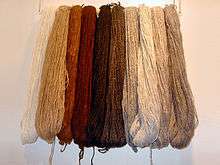Clothing material
Historically, clothing is, and has been, made from many clothing materials. These range from grasses and furs to much more elaborate and exotic materials. Some cultures, such as the various people of the Arctic Circle, have made their clothing entirely of prepared and decorated furs and skins. Other cultures have supplemented and replaced leather and skins with cloth. Cloth is either woven or knitted, and can be made from a large variety of fibers, which in turn can be natural, cellulose, or synthetic.
Humans have shown extreme inventiveness in devising clothing solutions to environmental hazards and the distinction between clothing and other protective equipment is not always clear-cut; examples include space suit, air conditioned clothing, armor, diving suit, swimsuit, bee-keeper's protective clothing, motorcycle leathers, high-visibility clothing, and protective clothing in general.
Cloth
Clothing is often made of cloth. There are many different types of cloth, with different names and uses. Main differences between types of cloth include how the cloth is made (woven, knitted, felted, and how those techniques were implemented), what fiber it is made from, and what weight the cloth is. Different types of cloth may be used for different types of clothing.
Examples of clothing materials
Common natural clothing materials are:
Other materials are made from synthetic fibers, primarily from petrochemicals, which are not generally biodegradable. Common synthetic materials include:
- Nylon was first produced in 1935. Nylon is a thermoplastic silky material. It became famous when used in women's stockings ("nylons") in 1940. It was intended to be a synthetic replacement for silk and substituted for it in many different products after silk became scarce during World War II.
- Polyesters include naturally occurring chemicals and synthetics. Natural polyesters and a few synthetic ones are biodegradable, but most synthetic polyesters are not. Polyesters may change shape after the application of heat and are combustible at high temperatures. They tend to shrink away from flames and self-extinguish upon ignition. Polyester fibers have high tenacity and E-modulus as well as low water absorption and minimal shrinkage in comparison with other industrial fibers.
- Spandex (elastane) is known for its exceptional elasticity. It is stronger and more durable than rubber, its major non-synthetic competitor. It was invented in 1959 by Charles Lewis French Jr. and Taylor.
Some less common clothing materials are:
- Acetate
- Cupro
- Flannel
- Lyocell
- PVC-Polyvinyl chloride
- Rayon
- Recycled or Recovered Cotton
- Recycled PET
- Recycled bob
- Tyvek
- Other Natural Fibers, including bamboo, jute, and hemp
Reinforcing materials such as wood, bone, plastic and metal may be used in fasteners or to stiffen garments.
See also
References
External links
- International Textile and Apparel Association, scholarly publications
- German Hosiery Museum (English language)
- Molecular Evolution of Pediculus humanus and the Origin of Clothing by Ralf Kittler, Manfred Kayser and Mark Stoneking (.PDF file)



.svg.png)